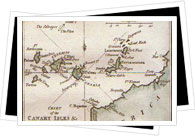
Music, stories, traditions, superstitions... the imagination has always been a major facet of the unique Canarian culture. In fact, long before the Guanche, Spanish Conquest and post-Conquest history of Tenerife, a combination of seamlessly interwoven legends and facts compose the earliest chunk of this Atlantic tropical paradise.
Long before the revolutionary discovery that the world was not, in fact, a flat table that would send sailors plunging into a black abyss should they sail too far, very few ventured far into the mysterious Atlantic Ocean. There is, however, evidence that the Canary Islands were known to Phoenicians, Greeks and Romans; yet very few people who reached the sunny isles returned to tell about it. The only possible explanation was naturally that the Atlantic Ocean was inhabited by vicious ship-destroying, crew-devouring monsters and angry gods who created violent storms and massive whirlpools on a whim. The Atlantic Ocean became the subject of epic legends, widely believed myths and great literary works.
In classical literature, the Canary Islands are often thought to be Paradise, the so-called Fortunate Isles, or the Elysian fields at the end of the world described in Homer's Odyssey and Virgil's Aeneid. Others believed it to be the visible part of the lost continent of Atlantis. When Zeus punished the Atlantes with debilitating volcano eruptions and tidal waves, all but the continent's tips - now the Azores, Madeira, Cape Verde and Canary Islands - sank far below the ocean's surface.
The author Pliny the Elder (1st century, A.D.) tells of a Carthaginian expedition to the Canary Islands sent by King Juba. They returned with giant dogs, from which the the archipelago derives its name; "can" or "canes" means "dog" in latin, and when the Carthaginians put a name to the islands, they called them the "Insularia Canaria" (Islands of the Dogs). Backing up the story, the islands still have native dogs today that are thought to be the very dogs to which Pliny referred centuries and centuries ago.
Legend has it that the Tenerife could even the lush Garden of Hesperydes, where the Greek god Atlas' three daughters (the Hesperydes) lived and cultivated gardens and apple orchards. One of Greek superstar Hercules' 12 legendary tasks was to kill the fierce dragon - who, by the way, had 100 flaming heads working to his advantage - that patrolled the surrounding seas and to then steal the Hesperydes' apples.
Since the dragon knew and trusted Atlas, Hercules made a deal: he would hold up the sky for Atlas while Atlas killed the dragon and collected the apples. The story goes that in every place that a drop of the dragon's blood fell a tree grew. Known known fittingly in the Canary Islands as their characteristic dragon tree, the tree has a massive trunk with bunches of twisting branches resembling the dragon and its many heads.
Learn more about later chapters of Canary Island history below!
-The Guanches
-Spanish Conquest
-Post-Spanish Conquest